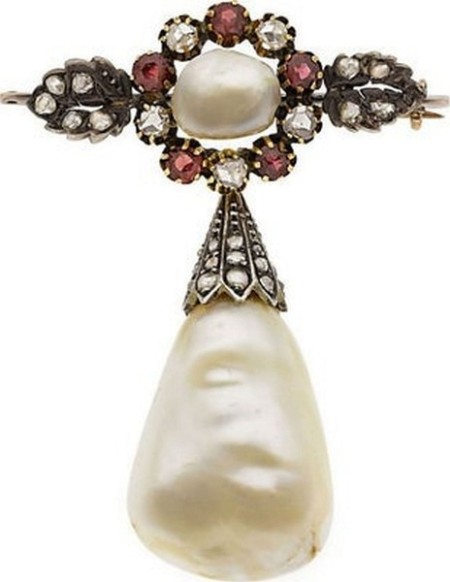
NEW YORK – Natural, cultured, baroque, keshi, mabe, freshwater, seawater, Akoya, Tahitian, South Sea — there are so many types of pearls. How do they differ?
All pearls, whatever their type, are born in inner shells of mollusks, by accumulating layers of nacre (mother-of-pearl secretions) around bits of irritant foreign matter. Those growing in soft-tissue areas expand freely, becoming round or teardrop shape. Those growing in more resistant muscular areas assume irregular shapes and curved, pinched or lumpy surfaces. These are known as baroque pearls.
As they grow, pearls also acquire subtle overtones or a soap-bubble surface iridescence called orient. Though they vary widely in size, larger ones are generally more valuable. Prices are also affected by their color, surface quality, symmetry, shape, orient and luster, their reflection of light.
Natural Pearls
Natural pearls occur spontaneously in both saltwater and freshwater mollusks. Because perfectly round ones are uncommon and costly, they are sometimes glorious collector items. Often they embellish exclusive brooches, rings and earrings. Since natural pearls rarely match, few become necklaces. Business Insider, a business and news website, recounts a notable exception. In 1909, Pierre Cartier, of Cartier’s jewelers, acquired a prestigious New York City residence in trade for a graduated, perfectly matched, double-strand necklace composed of 128 natural pearls, valued at $1 million.

Cultured Pearls
Today, most pearls on the market are cultured – created artificially in fresh or saltwater mollusks. They are not only less costly than natural pearls but also allow the creation of large numbers of consistently beautiful pieces of jewelry.
Freshwater cultured pearls, created by seeding lake, river, pond and pearl farm mollusks with polished, mussel-shell spheres, may be round or nearly round. Those seeded with harvested mantle tissue, however, produce baroque pearls. Though naturally white or cream-colored with lush pink, peach or lavender overtones, some are artificially dyed green, blue, yellow, brown, pink, purple or black. With their warm luster and varied sizes, freshwater pearls particularly suit fanciful jewelry designs.
Small, elongated, irregularly shaped keshis also grow in freshwater mollusks. Though commonly known as seed pearls, these are actually unintentional, unseeded byproducts of the pearl culturing process. They are available in a variety of shades and, due to many light-reflecting imperfections, are highly lustrous. When featured in rings, earrings or bracelets, keshis add a delicate touch of class. Cascading in sumptuous, multiple strands, however, keshis are the height of luxury.

Saltwater cultured pearls are raised in seas adjoining China, Japan, Korea, Vietnam, Australia, Tahiti, Thailand and Indonesia. Though less durable and more costly than freshwater pearls, they are larger, more lustrous and more sumptuous. Most, seeded with round or spherical beads, are round or teardrop shape.
There are three types of saltwater cultured pearls – Akoya, South Sea and Tahitian.
Akoya pearls, the most abundant, are prized for their classic beauty, high luster and attractive prices. Most are white, off-white or cream-colored with subtle green, silver, or pink overtones. Though the smallest of this type, an Akoya may reach as much as 10mm in size. Though some are baroque, teardrop or elongated in shape, most are perfectly round. Due to their consistent symmetry, Akoyas are favored for necklaces, rings, bracelets and earrings. Extremely lustrous, highly iridescent ones from Handama, Japan are the most desirable of all.

Large, satiny, slow-growing South Sea pearls are cultured off the coasts of Australia, Indonesia, and the Philippines in giant mollusks. These rare, round, pretentious teardrop, and baroque beauties, which may range up to a remarkable 20mm, are usually creamy white or champagne-hued with rich overtones. A single South Sea pearl ring is an eye-catcher. A multicolor South Sea bracelet is extravagant. But a necklace featuring perfectly spherical deep golden pearls, sometimes described as 24K, is priceless.
Tahitian pearls, farmed in French Polynesia, are the only naturally dark cultured pearls on the market. Though often called “black pearls,” these unique jewels range from white to near-black, many shimmering with pink, purple or multihued “peacock feather” overtones. Though Tahitian pearls may be oval, teardrop or baroque, perfectly round ones, especially if they are very dark, are most desirable. Irregularly shaped Tahitians, however, glimmer far more. They are also more affordable. Of note, only Tahitian pearls boast an internationally accepted standard of quality.

Mabe pearls, which are cultured on inner shells of both salt and freshwater mollusks, are affordable alternatives to traditional pearls of similar quality. These nearly round, flat-back, “half pearls,” known for their lusters and wide range of shades, are particularly suited to rings, earrings and pendants.
If South Sea mabe earrings, Akoya bracelets or Tahitian pearl necklaces are offered at suspiciously low prices, these are probably too good to be true. Because pearls are both popular and profitable, shell, mother-of-pearl, plastic and coated glass beads sometimes masquerade as the real thing.

Multiple observations may help separate true from false. Imitation pearls sometimes appear chalky or reveal chipped coatings when under bright light. They may feel smooth when gently rubbed one against another and often seem perfectly round. In addition, imitation pearls generally weigh less than real ones.
Real pearls, in comparison, feature glossy luster with subtle overtones. Due to minor surface imperfections, they create slight friction when rubbed together. Moreover, as all things in nature, they are rarely perfectly round. Real pearls, because they are organic, also suffer scratches and chemical damage.
Legend has it that Cleopatra, to demonstrate her vast wealth to Mark Antony, removed an exquisite, unimaginably expensive pearl earring from an ear, then dropped it into a vial of vinegar. When the pearl had dissolved, she drank it all down.
Today, any reputable gemologist or jeweler should be able to verify a pearl’s authenticity.
# # #



